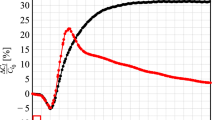Abstract
Operating characteristics of aeronautic and marine vehicles, as well as hydraulic machines designed for various purposes are largely affected by flow separation. Therefore, control of separated flows is an extremely important problem for modern aviation and marine engineering. Based on dynamometric measurements of forces and torque acting on model hydrofoils and the ship rudder, jet control of flow separation in cavitation-free and cavitation regimes at low and high angles of attack is studied. It is shown that generation of a near-wall jet can ensure a separationless flow around test models at angles of attack greater than 30 degrees. In this case, the lift coefficient of the hydrofoil can increase approximately by two or three times. Pressure fluctuations near the body and in its wake vanish due to flow stabilization; as a result, oscillations of hydrodynamic loads on the body decrease.
Similar content being viewed by others
REFERENCES
Litovkin, D., New Hydrofoil Ship May Revive Russian Shipping,Russia Beyond, 2013; https://www. rbth.com/science_and_tech/2013/08/11/new_hydrofoil_ship_may_revive_russian_shipping_28809.html.
Gornova, A.M., The Hydrofoil New Generation of “Valdai 45R,”SPIEF 2018, Center for Strategic Assessment and Forecasts, 2018; http://csef.ru/en/politica-i-geopolitica/510/sudno-na-podvodnyh-krylyah-novogo-pokoleniya-valdaj-45r-prezentovano-v-sankt-peterburge-v-ramkah-pmef-2018-8490.
Goldstein, S., Modern Developments in Fluid Dynamics, vol. II, Oxford: Clarendon Press, 1938.
Chang, P.K., Control of Flow Separation: Energy Conservation, Operational Efficiency, and Safety, Washington: Hemisphere, 1976.
Petrov, A.V., Energeticheskie metody uvelicheniya pod’emnoi sily kryla (Energy Methods for Increasing the Lift Force of the Airfoil), Moscow: Fizmatlit, 2011; ISBN 978-5-9221-1343-4.
Kozhukharov, P.G., Hadjimikhalev, V.H., Mikuta, V.I., and Maltzev, L.I., Hydrofoil Performance Control Introducing Tangential Liquid Jet, ASME Fluids Engin. Div., 1985, vol. 31, pp. 67–74.
Kozhukharov, P.G., Maltzev, L.I., and Mikuta, V.I., Hydrofoil with Jet Controlled Performance under Free Surface, Actual and Topical Problems of Ship Hydro- and Aerodynamics, in Proc. of 5th National Congress on Theoretical and Applied Mechanics, Varna, Bulgaria, 1985, vol. 1, pp. 26.1–26.8.
Kozhukharov, P.G., Milanov, E.M., Maltzev, L.I., and Mikuta, V.I., Rudder with Jet Controlled Performance behind Ship Hull, inActual and Topical Problems of Ship Hydro- and Aerodynamics, Proc. XIV Session of the Scientific-Methodical Workshop on Ship Hydrodynamics, Varna, Bulgaria, 1985, pp. 27-1–27-10.
Yosifov, K., Kozhukharov, P., Dimitrov, V., Mironov, B., Mikuta, V., and Maltzev, L., Experimental Study of Rudders with Jet Controlled Performance Operating in Uniform Flow Field, in Actual and Topical Problems of Ship Hydro- and Aerodynamics, Proc. XIV Session of the Scientific-Methodical Workshop on Ship Hydrodynamics, Varna, Bulgaria, 1985, pp. 42-1–42-5.
Timoshevskiy, M.V., Zapryagaev, I.I., Pervunin, K.S., Maltsev, L.I., Markovich, D.M., and Hanjalić, K., Manipulating Cavitation by a Wall Jet: Experiments on a 2D Hydrofoil, Int. J. Multiphase Flow, 2018, vol. 99, pp. 312–328.
Wang, W., Zhang, Q., Tang, T., Lu, S., Yi, Q., and Wang, X., Numerical Study of the Impact of Water Injection Holes Arrangement on Cavitation Flow Control, Sci. Progress, 2020, vol. 103(1), pp. 1–23.
Ushakov, B.A., Atlas of Aerodynamic Characteristics of Airfoils Tested in the T-1 Wind Tunnel Based at TsAGI, in Proc. of Zhukovskii Central Aerohydrodynamic Institute, no. 193, Moscow: TsAGI, 1935.
Gault, D.E., A Correlation of Low-Speed, Airfoil-Section Stalling Characteristics with Reynolds Number and Airfoil Geometry, NACA Technical Note 3963, 1957.
Bamber, M.J., Wind Tunnel Tests on Airfoil Boundary Layer Control Using a Backward-Opening Slot, NACA Report No. 385, 1931.
Chappell, P.D., Flow Separation and Stall Characteristics of Plane, Constant-Section Wings in Subcritical Flow, The Aeronaut. J., 1968, vol. 72(685), pp. 82–90.
Schlichting, H., Boundary-Layer Theory, New York: McGraw-Hill, 1955.
Maltzev, L.I., Migirenko, G.S., and Mikuta, V.I., Cavitation Flows with Cavity Closure on a Liquid Jet, in Investigations on Developed Cavitation, Kutateladze, S.S. and Migirenko, G.S., Eds., Novosibirsk, 1976, pp. 96–106.
Maltzev, L.I., Near-Wall Liquid Jet with a Free Outer Surface—Coanda Effect, Russian J. Eng. Thermophys., 1996, vol. 6(1), pp. 83–103.
Callenaere, M., Franc, J.-P., Michel, J.-M., and Riondet, M., The Cavitation Instability Induced by the Development of a Re-Entrant Jet, J. Fluid Mech., 2001, vol. 444, pp. 223–256.
Author information
Authors and Affiliations
Corresponding author
Rights and permissions
About this article
Cite this article
Maltsev, L.I., Dimitrov, V.D., Milanov, E.M. et al. Jet Control of Flow Separation on Hydrofoils: Performance Evaluation Based on Force and Torque Measurements. J. Engin. Thermophys. 29, 424–442 (2020). https://doi.org/10.1134/S1810232820030078
Received:
Revised:
Accepted:
Published:
Issue Date:
DOI: https://doi.org/10.1134/S1810232820030078




